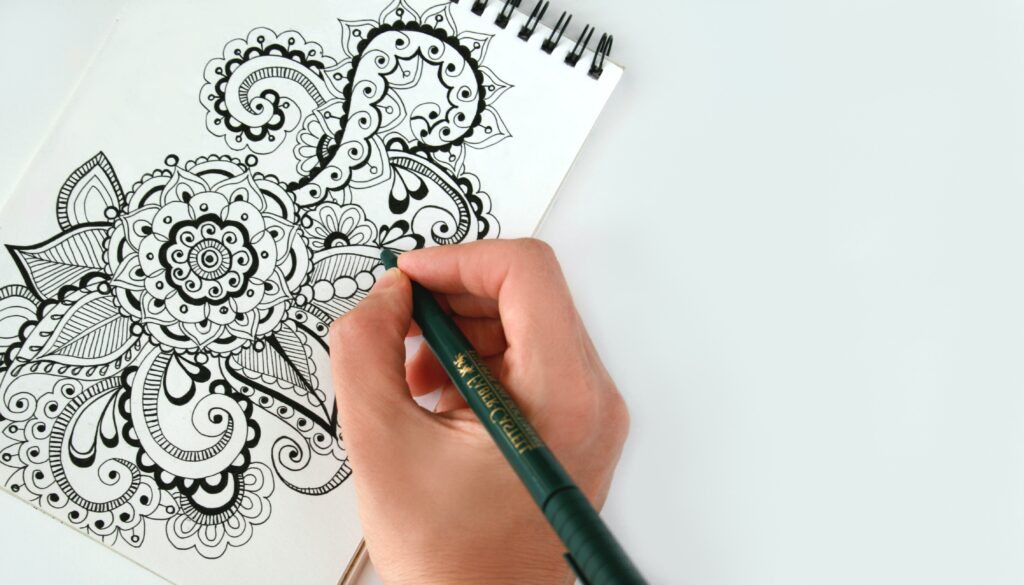Why Doodling Can Be Beneficial
Individuals with ADHD may have difficulty focusing, staying organized, and regulating their emotions. While medication and therapy are commonly used to manage ADHD symptoms, there are also additional strategies that can help. One such strategy is doodling. Doodling, or drawing simple images, can have numerous benefits for those with ADHD, including:
- Improved Focus – One of the main challenges for people with ADHD is maintaining focus. Doodling provides a visual and tactile activity that can help distract the restless mind and improve concentration. When a person with ADHD doodles, they can still listen to and process information while engaging their hands in a creative activity. This can lead to improved attention and retention of information.
- Reduced Anxiety – Anxiety is a common co-occurring condition with ADHD. Doodling can be a relaxing and meditative activity that helps to reduce anxiety and promote calmness. When a person with ADHD feels overwhelmed or stressed, doodling can serve as a healthy coping mechanism to alleviate these feelings.
- Enhanced Memory – Doodling can also help to enhance memory retention. Drawing visual representations of concepts or ideas can help to reinforce them in the mind. For people with ADHD who may struggle with short-term memory, doodling can be a helpful tool for retaining information.
- Helps Solve Problems – For reasons that are not yet fully understood, doodling helps to generate fresh ideas. Because this activity distracts folks from focusing on a given problem, it allows the unconscious mind to kick it around and inspire solutions.
- Improved Creativity – ADHD is often associated with creativity and out-of-the-box thinking. Doodling can be a way for people with ADHD to harness this creativity and express themselves visually. This can be especially beneficial in situations where verbal communication may be difficult or overwhelming.
- Improved Mood – Doodling can be a fun and enjoyable activity that can help to improve mood. When a person with ADHD engages in doodling, they are engaging in a form of self-expression that can be a positive outlet for emotions. This can lead to increased self-esteem and a more positive outlook.
The Biology of Doodling
Why can a simple thing like doodling have these benefits?
Abnormal levels of the neurotransmitter dopamine are thought to contribute to the symptoms of ADHD. Insufficient dopamine levels can affect attention and is involved in novelty-seeking behaviors. Brain imaging studies show dopamine-rich areas of the brain, like the frontal cortex, are affected by ADHD.
Doodling involves physically moving your hands to create a design on paper. Several studies have shown that physical activity, even small movements like doodling, can increase focus in children with ADHD by affecting the levels of dopamine in certain brain areas, similar to stimulant medications.
The default mode network (DMN) is made up of regions of the brain (including those involved in ADHD and memory) that are active when the brain is not engaged in a particular task. The DMN is more active in individuals with ADHD, making it difficult for them to stay on task and focus. Experts often recommend stretching or breathing exercises to calm the DMN and switch the brain into the reciprocal task positive network (TPN), which is active when your brain is focused. Doodling is thought to be another activity that can switch the brain from the DMN to the TPN, especially when you have ADHD.
Beyond the Doodle – Art Therapy
The creation or appreciation of art – as part of an art therapy treatment – is used to help people explore emotions, develop self-awareness, cope with stress, boost self-esteem, and work on social skills. Three are a number of techniques that may be used in art therapy including:
- Collage
- Coloring
- Drawing
- Finger painting
- Painting
- Working with clay
- Sculpting
- Photography
The focus is not on creating a product that is a creative representation of the outer world. It is more about the process of creating an expression of what is going on inside.
Doodling, by itself, may not be a full blown form of art therapy. But it can help someone with ADHD relieve their symptoms. Consider incorporating doodling into your daily routine as a healthy and enjoyable coping mechanism.
References
- https://www.psychologytoday.com/au/blog/mythbusting-adhd/202304/how-doodling-helps-kids-with-adhd-to-focus—
- https://psychcentral.com/blog/life-goals/2017/09/doodling-benefits—
- https://edgefoundation.org/using-the-artist-within-to-moderate-adhd-symptoms/—
- https://www.health.harvard.edu/blog/the-thinking-benefits-of-doodling-2016121510844—




Lena Sheffield
I’ve been a doodler since I could hold a crayon. Unfortunately I often doodled on parents important papers while on the phone, my papers often have doodles and I still
Pay attention.